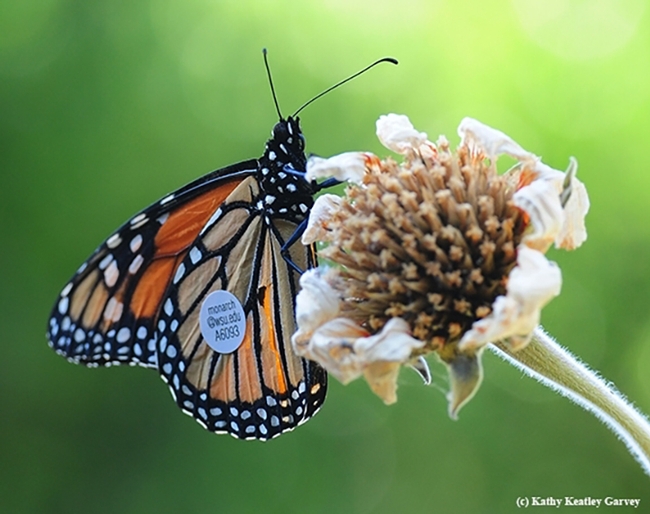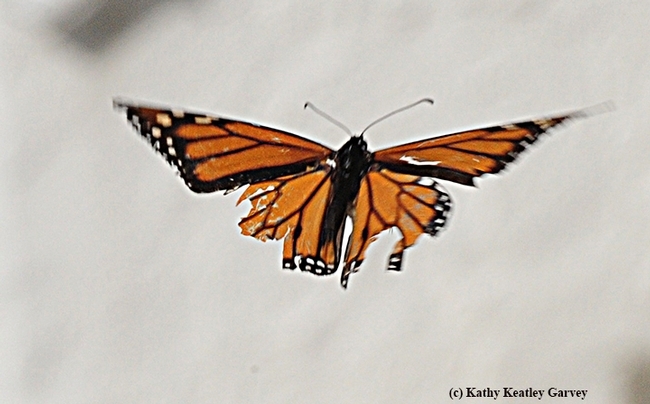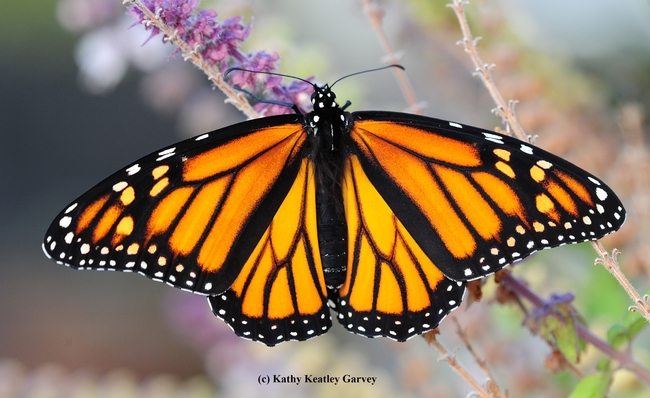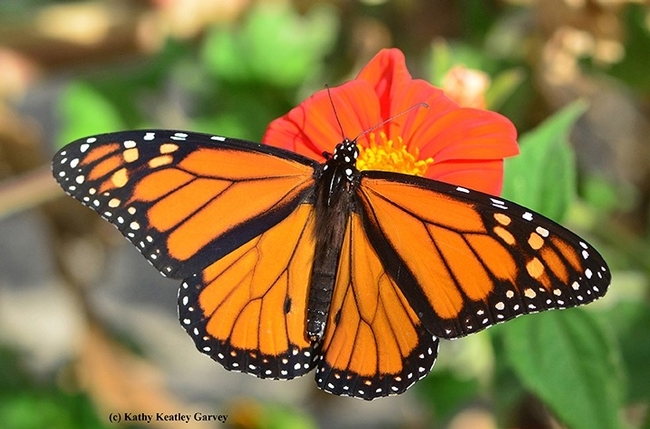
So, folks, if you're in their migratory pathway and anticipate seeing them head toward their overwintering sites in coastal California, don't get your hopes up.
They're not coming. They are either non-existent or few and far between.
But we remember when they did.
Back on Labor Day, Sept. 5, 2016, a male monarch tagged "monarch@wsu.edu A6093" fluttered into our pollinator garden in Vacaville. Washington State University entomologist David James traced it to citizen scientist Steve Johnson of Ashland, Ore., who had tagged and released it on Sunday, Aug. 28.
James calculated "No. A6093" flew 285 miles in seven days or about 40.7 miles per day to reach our Vacaville garden, which apparently is in a monarch migratory pathway. "Clearly this male is on his way to an overwintering colony and it's possible we may sight him again during the winter in Santa Cruz or Pacific Grove!” he said at the time. (No sightings reported.)
Still, it was a very good year for monarchs in 2016, as compared to previous years. We reared more than 60 in 2016. We saw dozens of migrating monarchs fueling up on nectar from the Mexican sunflowers (Tithonia rotundifola) and butterfly bush (Buddleia davidii). They arrived tattered and torn, and some could barely fly.
But come they did.
Not this year.
"It's been a very poor year for monarchs in the Pacific Northwest," James said. "In Washington, we had just two confirmed sightings of monarchs! This is the worst showing since I started taking records in 1999. I thought 2019 was bad (eight monarchs) but 2020 beat it."
"There were a handful of sightings in central and northern Oregon but they largely failed to cross into Washington," the entomologist said. "This is simply a result I believe of a very small overwintering population that had difficulty populating California and southern Oregon let alone locations further north."
"If future overwintering populations do not exceed more than 30,000, then this is what we can expect for the future; the monarch to be a rarity in Washington and BC."
Johnson, who rears monarchs in a vineyard in Ashland, says it was "a very poor year in the vineyard. We have three chrysalids right now and that will probably be it for us in the vineyard this year. They come from three 'cats that we found on the same day. We have seen far fewer monarchs than in any of the past years. Overall, to my knowledge, it has been a grim year in Oregon except for some isolated pockets."
Southern Oregon seemed to fare a little better for monarchs in the Pacific Northwest this year, James said, but "as Steve said, it was still way less than recent years."
"Idaho had quite a few monarchs, maybe as many as southern Oregon, but these arrived and bred from--I believe-- migrants that came from Mexico," the WSU entomologist said. "Populations in Arizona and Utah were also reasonable this summer. 'Leakage' 'of northerly spring migrants from Mexico is the ‘saving grace' of monarch populations in the West and may be the reason why monarchs can persist long-term in the West. This was a theory expounded by the late Lincoln Brower and I believe it has a lot of merit."
Johnson noted that the air quality in Ashland "at the moment (this morning) is 415—very hazardous."
How does all that poor air quality, all that smoke and ash from the wildfires raging across the West affect the migrating monarchs?
Thanks to James' tagging program and cooperators like Johnson, James now has "some limited data indicating monarchs do NOT have a problem migrating in very poor quality air. These data will appear in a publication I am preparing. Tagged monarchs released into poor quality air flew just as far and lived just as long as those that were released into good air."
Butterfly guru Art Shapiro, distinguished professor of evolution and ecology at UC Davis, who has monitored butterfly populations in Central California since 1972, has seen only six monarchs all year (the first one in Sacramento on Jan. 29) and "no eggs and no caterpillars at all." (See Bug Squad blog on his comments on "California monarchs on life support")
Naturalist Greg Kareofelas of the Bohart Museum of Entomology, UC Davis, has seen only one monarch all year and it was a female laying an egg on his milkweed in Davis. He is in the process of rearing it from egg to caterpillar to chrysalis to adult. It's a chrysalis now.
Lynn Kimsey, director of the Bohart Museum and UC Davis professor of entomology, and UC Davis forensic entomologist Robert Kimsey have not seen any in their Davis garden.
This year our Garvey family has managed to collect dozens of eggs and 'cats from our garden and rear them in three different batches. First batch: 5. Second batch: 11. The third batch? As of Sept. 1, we've reared and released 37 monarchs, with one chrysalis remaining. No. 38 should eclose in a few days.
Incredibly, our Vacaville pollinator garden seems to some kind of monarch magnet.
"I think Kathy and one gardener in the East Bay who is having a similar experience have all the monarchs in the region in their yards," Shapiro commented. "Very bizarre."
Very bizarre, indeed.
Attached Images:

This migrating monarch flew from a vineyard in Ashland, Ore. to a garden in Vacaville, Calif. in 2016. This amounted to 285 miles in seven days or about 40.7 miles per day, according to WSU entomologist David James, who studies migratory monarchs.(Photo by Kathy Keatley Garvey)

A tattered and torn migrating monarch in Vacaville, Calif. This image was taken in 2016. (Photo by Kathy Keatley Garvey)

A newly eclosed female monarch. (Photo by Kathy Keatley Garvey)

A newly eclosed male monarch. (Photo by Kathy Keatley Garvey)